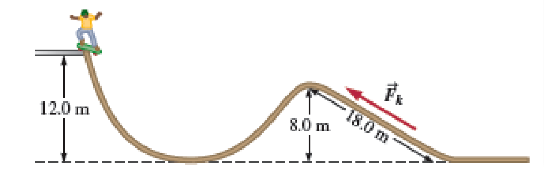Shawn (m = 45.0 kg) rides his skateboard at a local skate park. He starts from rest at the top of the track as seen in Figure P9.84 and begins a descent down the track, always maintaining contact with the surface. The mass of the skateboard is negligible, as is friction except where noted. a. What is Shawn’s speed when he reaches the bottom of the initial dip, 12.0 m below the starting point? b. He then ascends the other side of the
dip to the top of a hill, 8.0 m above the ground. What is his speed when he reaches this point? c. As he begins to descend again, down a straight, 18.0-m-long slope, he slows his skateboard down by using friction on the tail of the board. He is able to produce a friction force with a magnitude of 120.0 N. What is the change in thermal energy of the board–rider–track system as he descends the 18.0-m length of track? d. What is his speed when he reaches the bottom (the end of the 18.0-m length of track)?
FIGURE P9.84
84. (a) We begin by applying conservation of energy principles, as in Eq. 9.31, to the
Shawn-skateboard-track system from the start to the movement Shawn reaches the
bottom of the track. Because there is no friction during this motion, we expect ΔEth =
0. Also, there are no identification forces performing work on the system, other than
gravity, so Wtot = 0. Choosing the bottom of the track to be where y = 0, Eq. 9.31
becomes
(b) Again, we apply conservation of energy principles, from the start to the moment
Shawn reaches the height of 8.0 m above the lowest point. Because there is no friction
during this motion, we expect . Also, there are no identical forces performing
work on the system, other than gravity, so Wtot = 0. Choosing the bottom of the track to
be where y = 0, Eq. 9.31 becomes
(c) The change in thermal energy is the change in internal energy for the system and
can be found using Eq. 9.29.
(d) Again, we apply conservation of energy from the start to the moment Shawn
reaches the bottom at the very end (after the 18.0 m incline). There are no extra forces
performing work on the system, other than gravity, so Wtot = 0. Choosing the bottom of
the track to be where y = 0, Eq. 9.31 becomes

Trending now
This is a popular solution!
Step by step
Solved in 5 steps with 4 images


